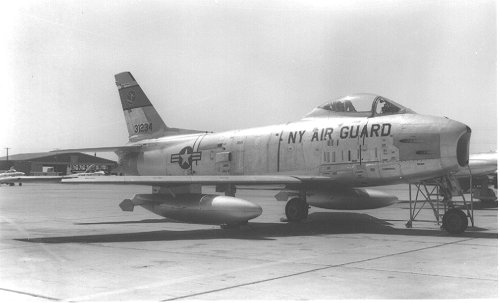
F-86H s/n 53-1234 pictured with 138th TFS in the US just prior to its crash on 17th April 1962.
Crash of F-86 Sabre 53-1234
Date: 17th April 1962
Pilot's Name: Capt. William C Kelly, AO2226563
Location: Baumholder Range, Germany (57 nm from Phalsbourg on heading 011 degrees)
Time of Crash: 0837 hrs local
Unit:
138th TFS, New York ANG (assigned to 102nd TFW, USAFE/17th AF)

F-86H s/n 53-1234 pictured with 138th TFS in the US just prior to its crash on 17th April 1962.
History:
On the night of 12/13 August 1961, the sudden construction of the Berlin Wall signified the start of the so-called Berlin Crisis. As a result, numerous USAF units were called upon to strengthen European forces, and in addition, a number of Air National Guard (ANG) squadrons were called to active duty. Significantly, three ANG F-86H squadrons were called up and sent to Europe. The 101st and 131st Tactical Fighter Squadrons (TFS), Massachusetts ANG and 138th TFS New York ANG were activated on 1st October 1961 under Project Stair Step, deploying their F-86Hs to Phalsbourg AB in France under Tactical Air Command (TAC). The three squadrons were further assigned to 102nd Tactical Fighter Wing, under the command of Major General Walter Sweeney, who had been on the Hiroshima B-29 raid in WWII.
The three squadrons deployed from Loring AFB, Maine through Goose Bay in Canada, to Sondrestrom in Greenland and on to Keflavik in Iceland. Staging from there to Prestwick in Scotland, the wingfs aircraft officially arriving in France on 11th November. Into 1962, the Stair Step augmentation of USAFE remained, and despite protests from the West, the Berlin Wall stood firm. To maintain proficiency, the three squadrons rotated through Wheelus AB in Libya for gunnery practice, and also flew regular simulated tactical missions throughout Europe. The crash detailed here took place on one such mission.
Narrative:
At 0702Z on 17th April 1962, F-86H s/n 53-1234 departed from Phalsbourg AB, France. The aircraft was number two in a three-ship flight, call sign "Cake Alpha", which had planned and briefed for a close support mission. The flight had filed for an IFR flight to maintain VMC within a 100 nautical mile radius of the Phalsbourg Tacan. Estimated time enroute was 1 hour 15 minutes and fuel onboard was 2 hours. Prior to the pilots leaving the briefing, the Flight Leader made the decision to proceed to the target area VMC underneath, as cloud tops were reported at 35,000 feet with moderate icing conditions in the clouds. The change of flight plan was approved by Moselle Control as VMC conditions were present below the cloud bases. A normal departure was made from Runway 06 and "Cake Alpha" Flight proceeded to the target area. Throughout the take-off and flight to the target area, the flight formation, radio procedures and route were normal.
The target was a number of armoured personnel carriers and troops, located on a hillside near Kirm, Germany.
The radar control agency "Obituary" was contacted and a successful radar paint established approximately 3 nautical miles north of Hahn AB, Germany. Cake Alpha flight proceeded toward the target area and contact was established with the forward air controller (FAC) "Arson Hotel". Receiving a vector and target briefing from the FAC, "Cake Alpha" flight flew to his location where the FAC established visual contact with the flight.
Under positive control of the FAC, "Cake Alpha" flight made two passes over the target area without visual contact with the target. On the third pass, visual contact by all three aircraft was made and the flight began its simulated attack. The flight made two or three more passes from a right-hand box pattern, the attack passes being made from north to south. On the second or third attack pass, the number two aircraft crashed into the trees in the target area.
The crash was observed by the number three aircraft and heard by the FAC. The FAC immediately directed the aircraft to leave the area. The remaining aircraft returned to Phalsbourg AB.
The pilot's body was recovered and taken to Ramstein AB, Germany.
Brief Details of F-86H s/n 53-1234:
An F-86H-10 aircraft, 53-1234 was built at North American's Columbus, Ohio plant and alloted construction number 203-6.
It was delivered to the USAF on 9th February 1955 and assigned to 413th Fighter Day Group at George AFB in California.
On 27th June 1956, '234 was reassigned to 312th FBW at Clovis AFB, New Mexico, then soon afterwards, assigned further to 83rd FDW at Seymour Johnson AFB, North Carolina on 10th October 1956. It became a 533rd FBS aircraft. The unit took '234 with it when it deployed to Eglin AFB in Florida for weapon training 6th March to 18th April 1957, before sending the aircraft to Warner Robins Air Materiel Area on 27th May 1957 for overhaul.
It returned to 83rd FDW ownership on 13th June 1957, before passing on to 4th FDW at SJ on 8th December 1957.
A maintenance stint with Southern California Aviation at Ontario CA followed, beginning on 11th February 1958, after which the aircraft flew out to a brief assignment with 102nd FIS NY ANG on 3rd June 1958.
Finally, on 29th August 1958, 53-1234 was taken over by 138th TFS at Hancock Field. It was officially "in place" at Phalsbourg on 1st November 1961, just just over four months prior to the accident.
This information was researched and made available by Duncan Curtis.
| Return to the Details Page |
| Return to Top of Page |
Updated: March 14, 2002